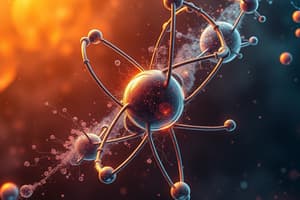Podcast
Questions and Answers
What distinguishes isotopes of the same element?
What distinguishes isotopes of the same element?
- Different numbers of neutrons (correct)
- Different atomic numbers
- Different numbers of protons
- Different numbers of electrons
Which statement is true about noble gases?
Which statement is true about noble gases?
- They do not exist in nature.
- They possess a full outer shell of electrons. (correct)
- They readily react to achieve stability.
- They have unstable outer electron shells.
What is the main characteristic of Rutherford's atomic model?
What is the main characteristic of Rutherford's atomic model?
- Atoms consist of positively charged particles only.
- The mass of an atom is concentrated in the nucleus. (correct)
- Atoms have equal distributions of mass throughout.
- Electrons are embedded within a positively charged sphere.
What is an example of an isotope of Carbon?
What is an example of an isotope of Carbon?
What is a feature of J.J. Thomson's atomic model?
What is a feature of J.J. Thomson's atomic model?
What type of charge do protons carry?
What type of charge do protons carry?
Which of the following correctly describes neutrons?
Which of the following correctly describes neutrons?
What is the significance of the atomic number (Z) of an element?
What is the significance of the atomic number (Z) of an element?
Why are noble gases considered unreactive?
Why are noble gases considered unreactive?
Which describes electronegativity in terms of periodic trends?
Which describes electronegativity in terms of periodic trends?
What was the main concept of phlogiston theory?
What was the main concept of phlogiston theory?
Which particle is found outside the nucleus of an atom?
Which particle is found outside the nucleus of an atom?
Which of the following is true about gases?
Which of the following is true about gases?
Flashcards
Proton
Proton
A positively charged particle found in the atom's nucleus
Neutron
Neutron
An uncharged particle found in the atom's nucleus
Electron
Electron
A negatively charged particle orbiting outside the nucleus
Atomic Number (Z)
Atomic Number (Z)
Signup and view all the flashcards
Electronegativity
Electronegativity
Signup and view all the flashcards
Noble Gases
Noble Gases
Signup and view all the flashcards
Valence Shell
Valence Shell
Signup and view all the flashcards
Reactivity of Noble Gases
Reactivity of Noble Gases
Signup and view all the flashcards
Isotope
Isotope
Signup and view all the flashcards
Atomic Number
Atomic Number
Signup and view all the flashcards
Rutherford's Atomic Model
Rutherford's Atomic Model
Signup and view all the flashcards
Isotope Example
Isotope Example
Signup and view all the flashcards
Noble Gas Stability
Noble Gas Stability
Signup and view all the flashcards
Study Notes
Phlogiston Theory
- A 17th-century scientific theory explaining combustion and oxidation.
- Developed by J.J. Becher.
- Proposed four elements: earth, air, fire, and water.
- Sulphur was believed to be the substance causing combustion.
- Suggested all matter contains a 'phlogiston' - a fatty, defining substance.
Atoms
- Basic building blocks of matter.
- Composed of three subatomic particles: protons, neutrons, and electrons.
- Nucleus: The central region containing protons and neutrons.
- Electron Cloud: The region surrounding the nucleus where electrons are located.
Atomic Structure Models
-
Rutherford's Atomic Model:
- Atoms have a positively charged central nucleus.
- Electrons orbit the nucleus.
- Most of the atom's volume is empty space.
-
Thomson's Atomic Model (Plum Pudding):
- Proposed in 1904
- Negatively charged electrons are embedded in a positively charged substance.
Isotopes
- Atoms of the same element with different numbers of neutrons.
- Have the same number of protons but vary in mass.
- Example: Carbon-12, Carbon-13, and Carbon-14.
- Isotopes have the same chemical properties but can differ in reaction rates.
Gases
- Possess mass, contrary to their seemingly weightless appearance.
- Classified as matter.
- Gas density is significantly lower than liquid or solid density.
Electronegativity
- Atoms' ability to attract electrons when bonded.
- Nonmetals have higher electronegativity.
- Metals have lower electronegativity.
- Electronegativity increases across a period and decreases down a group on the periodic table.
- Noble gases are unreactive due to their complete valence electron shells.
Studying That Suits You
Use AI to generate personalized quizzes and flashcards to suit your learning preferences.




